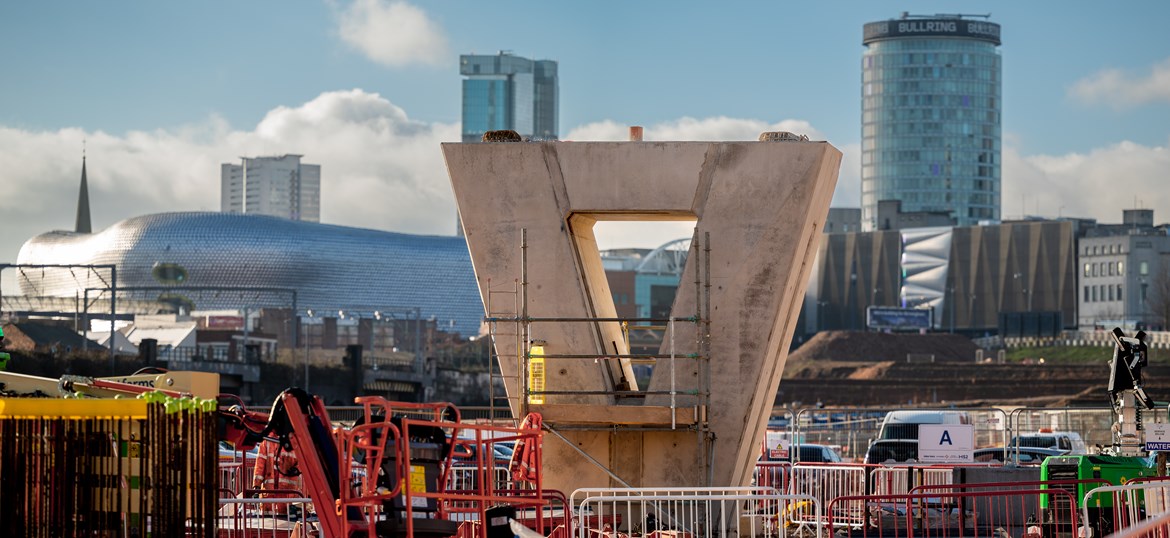HS2’s first Birmingham viaduct pier completed as work ramps up on city centre site

HS2 has revealed images of a big construction milestone in Birmingham city centre, with the completion of the first giant V-shaped pier for the 300 metres long viaduct that will bring high speed trains into the new Curzon Street Station.
The five-metre-tall structure is the first pier to be installed for the ‘Curzon No. 3 Viaduct’, which will be the final approach to HS2’s new seven platform station in the city centre. In total, 30 piers will be installed for this viaduct, with heights varying between five and six metres above ground level. This includes four steel tripod piers erected to span over the Digbeth Branch Canal.
To cut carbon, a steel industry by-product – ground granulated blast-furnace slag (GGBS) has been incorporated into the pier’s manufacturing as an eco-friendly concrete alternative to a traditional concrete mix. Also known as slag sand, GGBS will reduce the embedded carbon of the piers by more than 60%, while ensuring the structure will remain operational for over 120 years.
HS2’s Senior Project Manager for Curzon Street, David King said:
“It’s fantastic to see this first viaduct pier complete on the Curzon Street site, which starts to bring the design vision for this iconic structure to life. Construction on this site is supporting hundreds of skilled jobs in the region, and once built, Curzon Street Station will put Birmingham at the heart of the new zero-carbon high speed network.
“We’re also pleased to see eco-friendly materials being used in the construction method, supporting HS2’s ambition to cut carbon across the project.”
Over the last year, HS2’s main works contractor for the West Midlands, Balfour Beatty VINCI (BBV) have been carrying out foundation works on site to prepare for the installation of the piers, with the deepest pile reaching 34 metres below ground.
The pier was built in two segments, starting with a stem pour which links the viaduct foundation with the V-shaped part of the pier. The construction team then lifted the prefabricated steel cage above the stem and installed steel panels around the cage. Concrete was poured into the formwork and left to cure for one week before removal of the panels, forming the pier’s V shape.
Each pier will take up to 4 weeks to be fully installed on site, with the tallest pier reaching up to 6m above the ground. After the piers are in place, teams will begin to form the deck spans connecting the piers using system falsework and formwork with the longest span between each pier stretching over 28 metres across the site.
Georgios Markakis, Balfour Beatty VINCI’s Section Manager said:
“The progress we’re making at our Curzon Street site is clear to see, following the completion of the first viaduct pier. It’s a really proud moment for the team and everyone who’s helped to prepare the site over the last couple of years.
“This is just the beginning of a rolling programme, where 30 piers in total will be installed, before the decks are put in place later this year – then the viaduct will really start to take shape.”
Curzon No.3 Viaduct is 65 metres at the widest point, and as it approaches the station, the deck widens from a single deck at the eastern end to four separate decks at the western end, creating opportunities for a usable, flexible public space with maximised daylight under the viaduct.
The viaducts were designed through a Design Joint Venture of Mott MacDonald and Systra and Architects Weston Williamson + Partners, all working for BBV. Curzon Viaduct No.3 is part of the Curzon Street Station Approach area, which is made up of five connected viaducts between Duddeston Junction Viaduct and Curzon Street Station in central Birmingham.
Nearly 30,000 people are helping to build HS2, of which nearly 9,000 are employed in the West Midlands. When contractor Mace Dragados signed the contract to build HS2’s Curzon Street Station, they confirmed that over 1,000 jobs – including an estimated 100 new entrant roles and 100 new apprenticeship positions – will be created by the joint venture that will build HS2’s landmark station.
